Reading Viaduct ‘another opportunity lost’
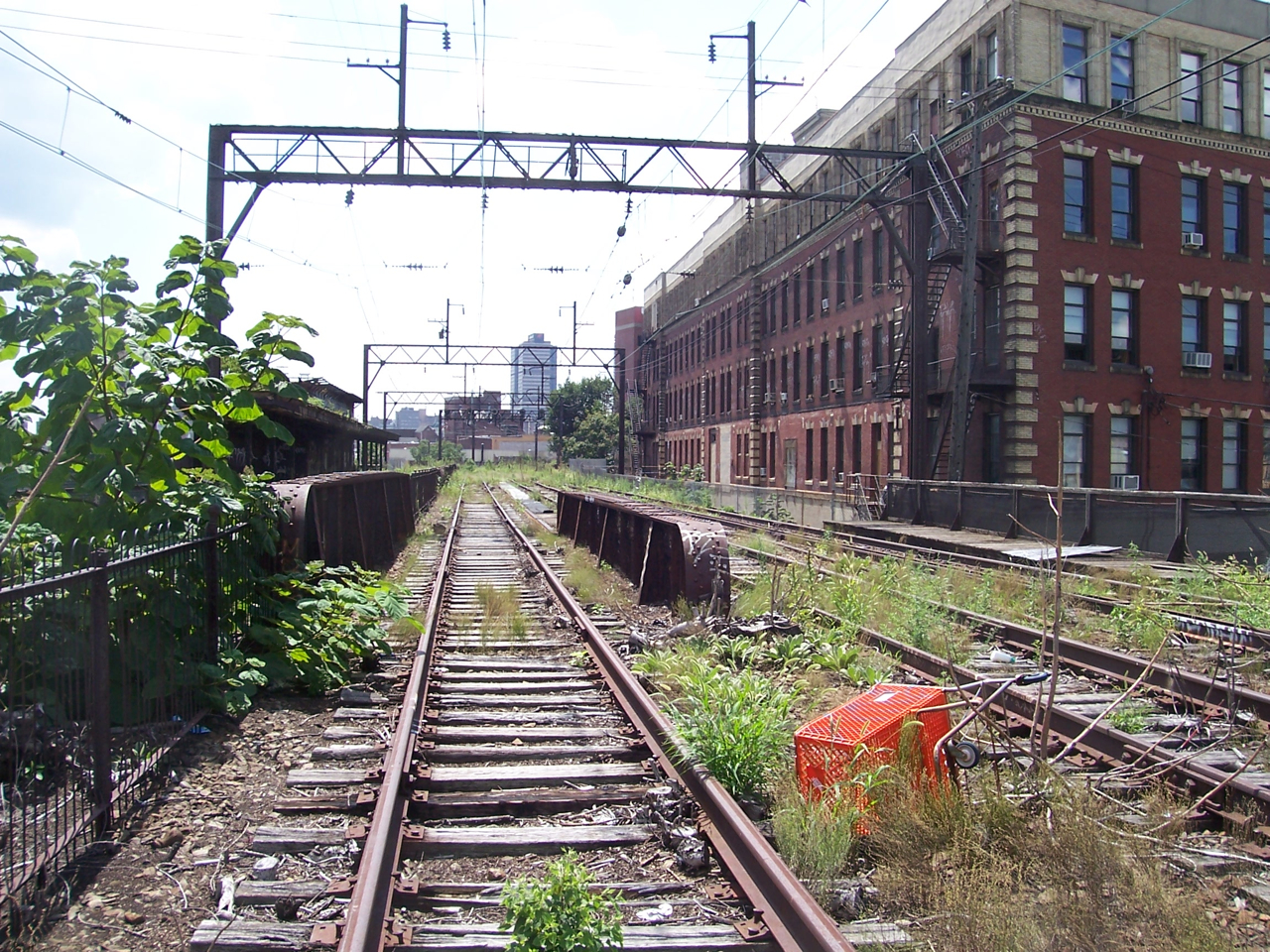
Lost in all the recent talk about the Reading Viaduct – the elevated, abandoned railroad bed that slices through the city from Vine Street northeast to Fairmount Avenue – is that if things had gone a certain way a decade ago, the City of Philadelphia would already own the property.
What’s more, Reading International Inc., the California-based movie theater and real estate company that is the descendant of the Reading Railroad, wanted to give the city between $2 million and $3 million to take the property off its hands, say veteran economic development professionals who were with the city’s Commerce Department at the time.
“The reason why nothing’s been developed is it is owned by the Reading company still,” said Andy Toy, who was the city’s first brownfields coordinator and worked at Commerce for 15 years, handling real estate transactions, zoning issues and sheriff’s sales. “It’s a liability for them.”
“They did have a deal, though,” Toy said this week, during a conversation about ongoing debates between parties that want to turn the Viaduct into Philadelphia’s version of New York’s successful High Line, and those who would rather tear it down. The period he was referring to was in the second Rendell mayoral administration, and before Toy left Commerce for another job.
“They were going to give us money to take it,” Toy said. “It got stalled because there were concerns about releasing the Reading company from liability, which is ridiculous. If we had done our [environmental] study right, we would’ve realized there would be no big surprises.”
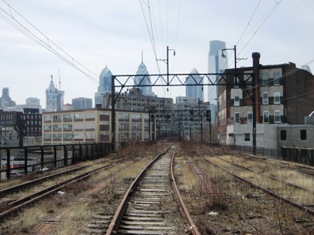
Toy, who believes turning the Viaduct into a park is not a great idea, said that at the time, he wanted to take control of it because the city already had – indeed, still has – partial liability. In a long ago agreement, liability for the railroad’s safety, environmental remediation and demolition was split between Reading, the city and SEPTA. Reading still maintained the majority of the liability – about 60 percent, if Toy’s memory serves.
“We were really getting close. It was another opportunity lost for the city,” he said. “Today it would be a different story.”
“The deal was to indemnify them as well,” said Stephen Mullin, a senior vice president and principal at Econsult Corp., who ran the city Commerce Department at the time. “The city and [the Philadelphia Industrial Development Corp., or PIDC] … we ended up saying it was way too risky, taking on all of the liability. Of course, my view of it is that the city has liability anyway.”
‘A lot to it’
Calls to Reading officials seeking comment were not returned this week.
“The only way to get that property into use was to take control of it,” said Toy, but the city’s Law Department backed away. “It was over $2 million they were going to pay us, but of course, the cost of the cleanup would be much more than that. And there’s the demolition costs, too.”
“If the demolition costs were $10 million and they’re only offering $3 million, you’re still obviously looking at something that is going to mean $7 million,” and that’s just for starters, Mullin said. “Besides, the city’s job shouldn’t be in land speculation. … It wasn’t like the city had any money to tear it down or clean it up.”
Toy said the idea was to get as much up-front money from Reading as possible, and then commence dismantling the Viaduct piece-by-piece, selling off and redeveloping parcels as they did so.
From planning studies he took part in for the Philadelphia Chinatown Development Corp. about five years ago, he estimates the total cost of cleanup and demolition would be about $9 million – significantly less than the $36 million that advocates for a converted park now maintain would be the price tag.
“It might be more now, and might be less,” Toy said. “It depends on the cost of steel, because there’s some salvage value too. There’s a lot to it.”
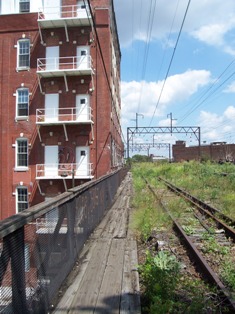
“That was a huge uncertainty,” said Craig Schelter, who was a senior executive with PIDC at the time. “Nobody knew quite what to do with that. And it’s always been a question mark since the Convention Center was done.”
(The city acquired and demolished part of the Viaduct, from the north side of Vine Street to the converted Reading Terminal Headhouse at 12th and Market streets, when the Convention Center was built.)
On Reading’s current position, “the more they think there’s an opportunity and the more they think there’s an interest,” the more they’ll likely charge for it, Toy said.
“The question right now is if there is serious interest on the city’s part,” said Toy. “I would guess the answer is no, because the city has no resources.”
That said, “some crazy developer” could come along and negotiate a sweetheart deal, he added, but said that could actually be worse – at least Reading is a large, publicly traded entity that is accountable for its safekeeping, while it is dormant.
As it happens, Reading’s offer was very likely on the table for just a short time. When Mayor John Street took office, a feasibility study was started to look at building a new stadium for the Phillies nearby, Schelter said. Such a study, publicized as much as it was, would have immediately increased the value of the Viaduct.
“When Street wanted to see whether a stadium could be built at 12th and Vine, one of the things that would have had to happen was to acquire a portion of the Viaduct,” Schelter said. “Things never got that far.”
High Line = high bar
Meanwhile, the highly touted, highly publicized High Line in Manhattan’s Chelsea neighborhood has already served two big roles for Philadelphia’s own version of a possible elevated park in the sky.
First, one of its original advocates, Joshua David, co-founder of the nonprofit Friends of the High Line in New York, was invited to Philadelphia in December 2003 by the Pennsylvania Horticultural Society.
“Nancy O’Donnell at [PHS] was aware of our efforts,” said Sarah McEneaney, co-founder of Philadelphia’s Reading Viaduct Project. “Joshua spoke and completely inspired us. We … invited neighbors and everybody we could think of, and started talking it up. We talked a lot with Joshua in the beginning.”
Second, with the High Line’s completion earlier this year and subsequent chorus of enthusiastic approval, it “has really lit a fire under everyone, and made a lot of people see what our’s could be – when maybe they couldn’t before,” said McEneaney, an artist and founding member of the Callowhill Neighborhood Association, where she has lived for 30 years.
The Viaduct is about a mile in total length and close to five acres in overall size.
McEneaney and her partners on the Reading Viaduct Project have met with a whole host of city and state officials, along with the Rails to Trails Conservancy, a national group. The Philadelphia Water Department has been in recent contact, she said, regarding the possible use of federal stimulus money for “green infrastructure” projects.
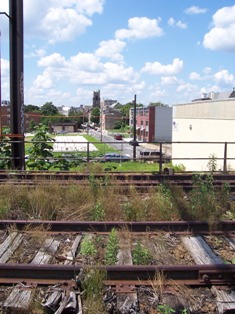
“They are interested because it is essentially a giant green roof already,” McEneaney said. “And they are interested in doing a more up-to-date environmental study.”
McEneaney said she’s also given recent tours of the Viaduct to high-level, local economic development executives, including Paul Levy, executive director of the Center City District and the Central Philadelphia Development Corp.
“They were very specific, talking about acquiring it from Reading, and that this should be a public-private partnership,” she said of Levy and those who came with him to meet with her. “All along, we thought that was the way we were going to go with this. It doesn’t have to cost $150 million, like the High Line. One thing good is that Reading has always said they want to get rid of it all at once – not piecemeal.”
“I think it’s a thing that’s really worth exploring,” said Alan Greenberger, executive director of the City Planning Commission. “Not just because the High Line in New York is cool. I mean, it is cool. But, it’s just one of those things that’s sitting in our midst that we can drive opportunities on.
“There are different points of view on it, which I’ve talked to some people in Chinatown about. I think in general, we’re in agreement that it’s a great asset that should be taken advantage of. The only objection we hear is that its continued existence makes redevelopment tough on a number of sites, because of the complicated geometry – it cuts against Ridge Avenue [and] makes a lot of oddball sites.”
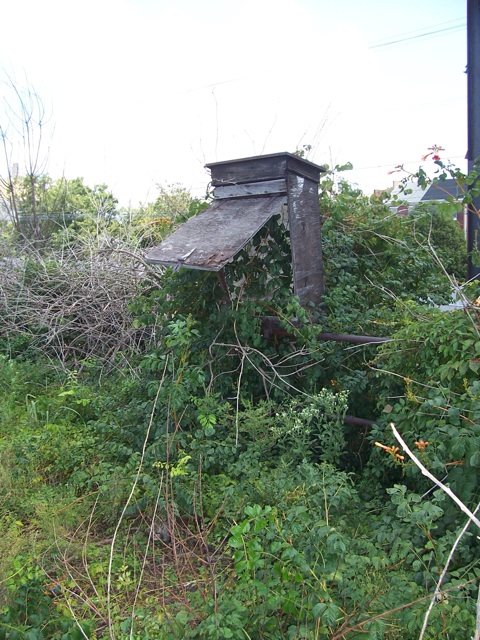
Atop Viaduct, north of Spring Garden
The Chinatown Viaduct plan(s)
Voices opposing the retention of the Viaduct were raised during the creation of Chinatown Neighborhood Plan, published in December 2004 by the Philadelphia Chinatown Development Corp., with help from the Delaware Valley Regional Planning Commission and the design firm Kise, Straw & Kolodner.
Other stakeholder groups involved included Asian Americans United and McEneaney’s Callowhill Neighborhood Association.
Greg Heller has been a planning and design analyst for the DVRPC and is about to move on to a position at the Enterprise Center (where Toy works) as managing director for economic growth and community revitalization. He wrote recently in the “Urban Direction” blog that the Chinatown Neighborhood Plan “describes a community that has slowly been hemmed in to the south, encouraged to look north for future expansion.”
He said the Viaduct is only a piece of the plan, but “clearly an important piece of the Chinatown puzzle.”
“Some in the Chinatown community see the land under the viaduct as dark, dirty and unsafe,” Heller wrote. “At the same time, some see it as prime real estate for the public sector to gain control, demolish the Viaduct, and redevelop the land as much needed affordable housing. Some also see the Viaduct’s diagonal northern spur as a hindrance to positive growth, creating a swath of small, triangular parcels that cut through the neighborhood.”
The plan itself acknowledges the rift, but a compromise that includes “selective demolition” could have legs, and it is something that Toy supports (though his personal preference remains complete removal).
Heller explains the compromise well in his posting: “The quarter-mile, masonry-supported spur west to Broad Street would be retained and transformed into a park. The northern spur would be retained for about 0.2 miles, up to Ridge Avenue, where it would ramp down to the surface and connect with a planned new ‘town square’ park, surrounded by mixed-use development. In this compromise solution, the remaining 0.4 miles of the northern spur of the viaduct would be demolished. This compromise would allow Chinatown to develop its own ‘dramatic downtown overlook’ or ‘sky park’ while also clearing some land for redevelopment.”
In this scenario, the remaining part of the Viaduct would form a sort of cursive (and appropriate) “V” shape, with the main line cut off near tiny Noble Street, between 10th and 11th – four blocks south of Spring Garden Street.
But, to some backers of a Pennsylvania Environmental Council effort to re-make Spring Garden Street into the city’s connector for the ambitious East Coast Greenway, a direct connection to even more bike and walking trails on a redeveloped Viaduct would seem to be a perfect marriage of old and new green infrastructure. It would provide a natural southern route into Center City for users of the Greenway, which seeks to link future green trails on the Delaware River and the recently completed Schuylkill River Banks.
McEneaney doesn’t buy the argument that small, irregularly shaped parcels formed by the Viaduct would hinder development. On the contrary, she and other proponents of a park say it would attract investment, just as the High Line is doing in Chelsea. She is disheartened by residents who can’t see her vision of the Viaduct as a “less fancy” and larger version of the New York High Line.
“I just can’t understand it, and feel like I’m never going to understand it,” McEneaney said of those who wish to tear it down – or even those who espouse the compromise plan. “I wish they would come around. The argument just doesn’t make sense.”
Toy defers to McEneaney’s knowledge of the Callowhill neighborhood and her longstanding stature as a resident, but said, “Well, she hasn’t developed housing. It is so difficult in Philadelphia to develop affordable housing. You can’t get land for decent numbers, and here’s an opportunity to do that. As [the Chinatown Development Corp.], it takes us five or seven years to develop a project, because getting site control is so difficult.”
In the areas north of Vine Street, where Chinatown seeks to expand into, property values are much less expensive than south of Vine, he said.
“Over time, the neighborhood has gotten squeezed and squeezed,” Toy said, referring to large municipal projects such as the Gallery, the Vine Street Expressway and the Pennsylvania Convention Center, among others. “The benefit of a park is pretty obvious when you think of the pretty pictures, but the value that Chinatown adds is enormous to Philadelphia, and extending it up to Spring Garden along 10th Street, it’s a homerun for the city.”
As for the two sides battling over the Viaduct, “We really did come to a middle ground and a compromise,” Toy said. “Until we come to an agreement on it, nothing will get done.”
“It’s sitting in our midst in an area that should grow,” Greenberger said. “So what we want to do is really explore it more, and understand how you would develop it.
“You’ve got this sort of odd thing flying through space. How do you take advantage of it? We need to explore that in a little more detail, so that we can then go back and talk to developers. Planning and Commerce need to study it more thoroughly in order to understand its development potential.”
“In the Market East plan, we’ve talked about wanting to drag it back across Vine Street, and sort of land it in that zone behind the Convention Center,” said Greenberger, “so that the benefits of the thing accrue to that as well. It is the kind of zone that nobody knows quite what to do with.”
Terry Gillen, Mayor Michael Nutter’s senior economic development advisor and executive director of the city’s Redevelopment Authority, said this week that she has not studied the Viaduct, and that no related projects are on the RDA’s radar.
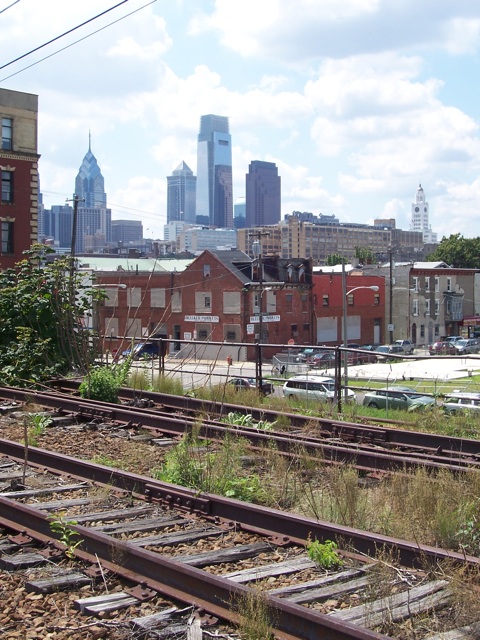
Southwestern view
Banking on rails
The Viaduct’s owner, Reading Entertainment, is now a movie theater company with operations in the United States, Australia and New Zealand. It is part of Reading International, a real estate firm that is the successor to the Reading Railroad. Most of Reading’s properties were conveyed to government-owned Conrail in 1976.
On the Reading International Web site, within a list of its properties around the world, the company says it also owns “various miscellaneous land holdings related to our historic railroad activities, comprising approximately 318 acres.” Of that land, most of it “is located in rural areas of Delaware and Pennsylvania, and is only of speculative value.”
The Viaduct’s future holds nothing but question marks. Currently, though, owing to the success of the High Line on Manhattan’s meatpacking district, there seems to be momentum in favor of saving it.
“It’s very exciting that everyone is coming together on this,” McEneaney said. “Everything is sort of on hold for now, but the recession won’t last forever.”
Aside from the High Line, advocates for a beautified Viaduct point to Paris, where La Promenade Plantée is another high-profile success story of a former rail line that’s been re-used and embedded into the fabric of a vibrant city.
In Chicago, efforts are underway to refurbish the three-mile Bloomingdale line, which is already in use as a bicycle path. Other big cities, such as Atlanta, have similar proposals pending.
Under the National Trails System Act, passed by Congress in 1983, there are other options for the Viaduct, but they would seem to necessitate cooperation with Reading Entertainment. A legal conversion method known as “railbanking” emerged from that law, which has already allowed for the conversion of 4,400 miles of ground-level rail corridors in 33 states, according the Rails-to-Trails Conservancy.
The act states that railbanking is “a voluntary agreement between a railroad company and a trail agency to use an out-of-service rail corridor as a trail until a railroad might need the corridor again for rail service. Because a railbanked corridor is not considered abandoned, it can be sold, leased or donated to a trail manager without reverting to adjacent landowners.”
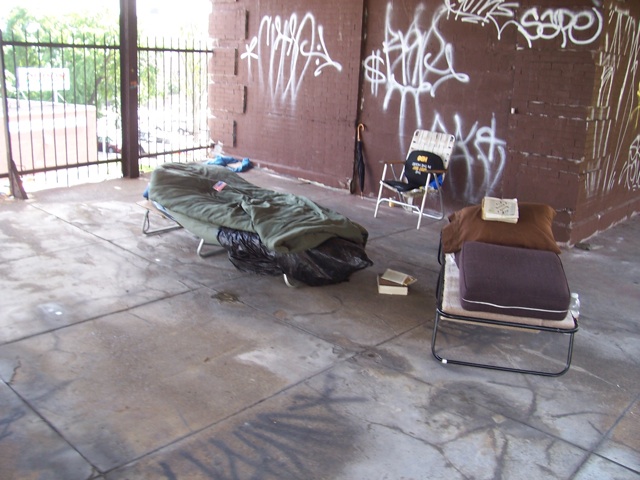
Platform atop Spring Garden Street station
Boots on the ground
A good hard look at the Viaduct, though, from below at street level, and above on the rail bed itself, tells you one undeniable truth: it is utterly abandoned. Ill-kept, filthy spaces beneath the Viaduct are laced with patched-up fencing and razor wire, darkening large portions of many blocks in broad daylight. Prostitutes and small-time drug dealers were not hard to spot on at least two underpass blocks on a recent mid-week day at about 1 p.m.
Topside, kindling-dry wooden ties and rusted, twisted rails are clotted with weed trees as high as six feet in spots. Broken bottles and vials and ancient railway detritus is everywhere underfoot. A platform and abandoned station house on the north side of Spring Garden Street still provides shelter for an undetermined number of homeless people. Iron safety railings are gone, or damaged irreparably, in spots. Warped, rotted-out wooden walkways, only partially secured by decades-old nails, are literally death traps.
Just looking at the Viaduct on Google Maps is enough to get one excited about its possibilities. If you visit the High Line, like we did recently, you get even more giddy.
But a couple of hours of intense scrutiny of the Viaduct makes it clear that it shares very little in common with the High Line, even if nothing had yet been done to the New York property.
“Maybe the High Line in Chelsea makes sense – it’s a straight line and doesn’t take out development opportunities,” said Toy. “The Reading Viaduct is curvilinear” and runs through several neighborhoods.
“To me, there’s very little comparison,” Schelter said. “The whole scale is very different. Plus, the overall paucity of residential [housing] makes it not at all similar.”
The High Line is a truly elevated structure, resting on steel girders that allow the eye to grasp the streetscape beyond and between it. It’s a sort of propped-up throughway in the sky. The Reading Viaduct, on the other hand, is an enormous earthen presence, creating valleys, tunnels and grime-besotted urban caves.
It meanders along two spurs and is much, much larger than the High Line, especially in the amount of infrastructure to negotiate. It is more like a long, low mountain than a traditional urban, elevated train platform.
McEneaney was speaking about her own Reading Viaduct Project when she said the railway, now more than a century old, needs a savior – an individual or well-funded, determined group – but no matter what the desired outcome, she could have been speaking for the entire city, including the residents of the neighborhoods most directly affected.
“We haven’t found a champion yet,” she said. “This project needs a powerful champion.”
Contact the reporter at thomaswalsh1@gmail.com.
ON THE WEB:
Reading Viaduct Project:
www.readingviaduct.org<http://www.readingviaduct.org>
Philadelphia Chinatown Development Corp.:
www.chinatown-pcdc.org<http://www.chinatown-pcdc.org>
Reading International: www.readingrdi.com<http://www.readingrdi.com>
The High Line: www.thehighline.org/<http://www.thehighline.org/>
La Promenade Plantée:
www.promenade-plantee.org/<http://www.promenade-plantee.org/>
Rails-to-Trails Conservancy:
www.railstotrails.org<http://www.railstotrails.org>
New York Times (“For High Line Visitors, Park Is a Railway Out of
Manhattan,” July 21, 2009):
http://www.nytimes.com/2009/07/22/nyregion/22highline.html
Philadelphia Inquirer (“Parkland in the air,” Aug. 23, 2009):
http://www.philly.com/inquirer/currents/54227192.html
WHYY is your source for fact-based, in-depth journalism and information. As a nonprofit organization, we rely on financial support from readers like you. Please give today.



